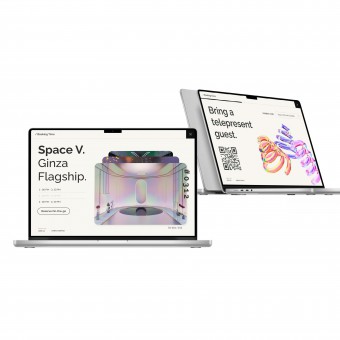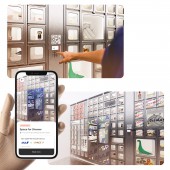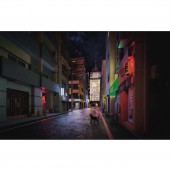
| THE AWARD |
| CATEGORIES |
| REGISTRATION |
| SUBMIT YOUR WORK |
| ENTRY INSTRUCTIONS |
| TERMS & CONDITIONS |
| PUBLICATIONS |
| DATES & FEES |
| METHODOLOGY |
| CONTACT |
| WINNERS |
| PRESS ROOM |
| GET INVOLVED |
| DESIGN PRIZE |
| DESIGN STORE |
| THE AWARD | JURY | CATEGORIES | REGISTRATION | PRESS | WINNERS | PUBLICATIONS | ENTRY INSTRUCTIONS |
Spacev Vending System Experience by Tiange Wang and I-Yang Huang |
Home > Winners > Design #149345 >Interview |
 |
|
FS: What is the main principle, idea and inspiration behind your design?
TW: The main principle behind SpaceV is to leverage the potential of shared economy and unmanned retail to address the need for affordable, accessible, and private spaces in urban environments. Inspired by vending systems and private spaces, SpaceV serves as a refuge for urban dwellers seeking to maintain their physical and mental wellbeing.
FS: What has been your main focus in designing this work? Especially what did you want to achieve?
TW: Our focus in designing SpaceV was to provide a flexible, personalized, and private wellness solution that is easily accessible and affordable. We sought to shift the emphasis of wellness from physical perfection to a more holistic approach, enhancing mental and physical wellbeing through various activities.
FS: What are your future plans for this award winning design?
TW: Our future plans for SpaceV involve continual enhancement of the digital interface and the integration of newer technologies to refine the user experience. We also foresee exploring partnerships to extend SpaceV's reach across different cities and cultures, making wellness an inclusive, global phenomenon.
FS: How long did it take you to design this particular concept?
TW: SpaceV is a complicated project that involved extensive research, intricate design, detailed visualization and collaboration. it was a lengthy process that took several months to complete.
FS: Why did you design this particular concept? Was this design commissioned or did you decide to pursuit an inspiration?
TW: The design for SpaceV was not commissioned; instead, it was inspired by the urban need for easily accessible and private wellness spaces. Recognizing the potential of shared economy and unmanned retail systems, we pursued the idea of creating a unique wellness experience.
FS: Is your design being produced or used by another company, or do you plan to sell or lease the production rights or do you intent to produce your work yourself?
TW: Considering its digital-physical nature, potential collaborations with other companies or plans to sell or lease production rights could be possible future avenues.
FS: What made you design this particular type of work?
TW: We were moved to design SpaceV to address the growing need for private, affordable, and accessible wellness spaces within urban environments. Recognizing the shortcomings of conventional fitness centers, we envisioned a flexible solution that promotes holistic wellbeing.
FS: Where there any other designs and/or designers that helped the influence the design of your work?
TW: While there are no specific designers or products we see as direct influences and precedents, the design of SpaceV is informed by existing vending systems, shared economy models, and wellness spaces.
FS: Who is the target customer for his design?
TW: The target customer for SpaceV is any individual living in an urban environment who seeks accessible, private, and affordable wellness spaces to engage in activities such as exercise, meditation, relaxation, or other forms of physical and mental wellbeing.
FS: What sets this design apart from other similar or resembling concepts?
TW: What sets SpaceV apart is its blend of digital and physical aspects, promoting a personalized, flexible, and private wellness experience. Unlike conventional fitness centers, it offers a holistic, inclusive approach to wellness, addressing both physical and mental wellbeing needs.
FS: How did you come up with the name for this design? What does it mean?
TW: The name SpaceV represents a combination of 'Space' and 'Vending'. It captures the essence of the project, offering a space-vending system for wellness activities in the city, similar to how vending machines or Amazon lockers work on a room-scale level.
FS: Which design tools did you use when you were working on this project?
TW: Due to the digital-physical blend of SpaceV, we used a combination of physical prototyping and digital tools, including software for 3D visualization, user interface design, and system management.
FS: What is the most unique aspect of your design?
TW: The unique aspect of our design lies in the blend of physical and digital aspects, creating a 'phygital' wellness experience. This seamless integration of technology and physical space provides a high degree of personalization, flexibility, and privacy in wellness routines.
FS: Who did you collaborate with for this design? Did you work with people with technical / specialized skills?
TW: The unique complexity of the SpaceV involved a multi-disciplinary team. This team included individuals with specialized skills in architectural design, user experience, service design, and technologist.
FS: What is the role of technology in this particular design?
TW: Technology plays a crucial role in SpaceV. It facilitates the operational aspects of space booking, customization, and management. Further, it enhances the user experience with digital interfaces, indoor navigation, AR wayfinding, and allows for telepresence interactions.
FS: Is your design influenced by data or analytical research in any way? What kind of research did you conduct for making this design?
TW: Yes, our design was significantly influenced by data and analytical research. We conducted typological and literature research to understand contemporary wellness practices, spatial requirements, and user expectations. These insights helped shape SpaceV.
FS: What are some of the challenges you faced during the design/realization of your concept?
TW: We faced challenges in designing a system capable of handling reservation, management, and wayfinding, while ensuring minimal human interference. Achieving the balance of automation, privacy, inclusivity, and the functional-physical blend posed a unique challenge.
FS: How did you decide to submit your design to an international design competition?
TW: The decision to submit SpaceV to an international design competition was likely driven by the desire to gain recognition for the innovative approach to wellness, expose the concept to a wider audience, and potentially attract future partnerships.
FS: What did you learn or how did you improve yourself during the designing of this work?
TW: During the design of SpaceV, we deepened our understanding of wellness needs in urban environments. We honed our ability to blend digital and physical design elements, creating a 'phygital' experience. The project improved our skills in research, prototyping, and designing complex systems.
FS: Any other things you would like to cover that have not been covered in these questions?
TW: We believe it's worth noting that SpaceV aims to redefine how wellness is perceived in urban landscapes. It challenges the norm of fitness centers by providing a holistic, inclusive, and accessible wellness experience, making it an integral part of people's everyday lives.
FS: Thank you for providing us with this opportunity to interview you.
A' Design Award and Competitions grants rights to press members and bloggers to use parts of this interview. This interview is provided as it is; DesignPRWire and A' Design Award and Competitions cannot be held responsible for the answers given by participating designers.
| SOCIAL |
| + Add to Likes / Favorites | Send to My Email | Comment | View Press-Release | Translations |





